|
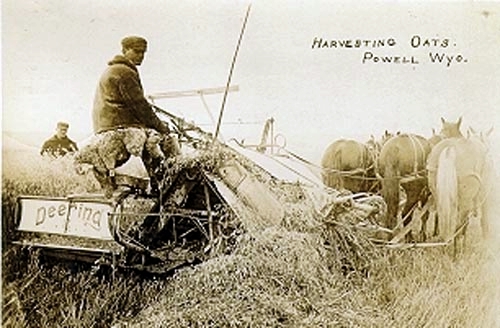
Harvesting Oats, Powell, 1915.
As lands became available, settlers from elsewhere put in claims for small farms.
Among those proving up a claim for an eighty-acre farm was Walter W. Durand originally from
Bates County, Missouri. On November 18, 1919,
the Lander Land Office issued a patent to Durand for Farm Unit "C," or Lots forty-one E and forty-one
F, of Lot forty-one Township 56 N., Range 99 W., a few miles northwest of
Powell near Bitter Creek. For the next 20 years, Durand and his wife Effie Jane farmed and reared
their family including a son, Walter Earl Durand.
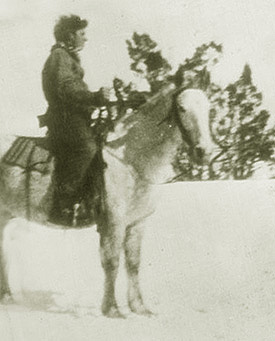 Earl Durand Earl Durand
Earl was a strapping lad, blue-eyed, blond, and
6 ft. 3 inches in height. He dropped out of school after the eighth grade. After dropping out of school, he
headed south toward Mexico on a saddle horse. along the way he was arrested and thrown in jail twice, once in
Saguache County, Colorado, where the sheriff thought he looked suspicious and might be wanted for something.
Investigation revealed that he was not wanted. The second time in New Mexico where it turned out
there was no evidence sufficient to charge him with a crime. In 1932, Earl moved to the Mojave. Bill Monday, a Cody pilot, recalled
that Earl related that he one occasion crossing the desert would have perished except that he managed to
snare a wildcat and ate it raw.
Earl returned to Powell and lived in a tent in his parents' back yard. He loved to hunt and would disappeared into
the wilderness for six weeks at a time. He was familiar with all parts of Park County, including the the North Fork west of
Cody, the rugged and isolated Sunlight Basin to Cody's north, and the Beartooth Mountains up on the
Clarks Fork on the Montana Line. Ear had a reputation of being a good marksmen. It was said that if one
threw a baseball into the air, Earl coult hit it with four shots before it hit the ground.
On Friday, March 24, 1939, the topic of conversation in Powell was the
100 man posse searching for Earl. Undoubtedly, it certainly would have been discussed at the Coffee Cup Cafe
next door to the bank. Every small town seems to have a cafe similar to the Coffee Cup where in the morning local businessmen and others
would gather at a communnal table for coffee and to pass on the daily politics and gossip. For years under various owners, the Coffee Cup Cafe was an
institution in Powell, first the "old" Coffee Cup Cafe and later the "new' Coffee Cup Cafe on Second Street.
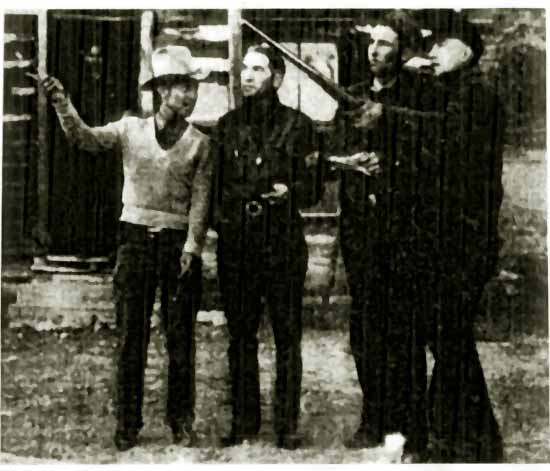
Four unidentified members of the Durand Possee, 1939..
The high sheriff, Frank Blackburn, was himself directing
men in the Beartooths near Clark fifty-five miles to the Northwest. The area was one in which one could easily
hide. Indeed, Chief Joseph himself eluded the army there. The hills were steep and provided an easily defended position.
In Cheyenne,
Governor Nels H. Smith had previously authorized members of the Montana National Guard to cross the border into
Wyoming to assist the posse. Bill Monday was conducting an aerial search for Earl. It was rumored that Bill had armed his
plane with gas bomb to drop on Earl is he was seen. Sheriff Blackburn had requested that the Governor let the National Guard loan him
a mortor to fire shells at young Durand. That morning, Johnny Gawthrop, a 21-year old
teller in the First National Bank of Powell, told an officer of the bank, Maurice Knutson, that he had
a horrible night. He had imagined that Earl would come into the bank Knutson reassured him that there was
no danger.
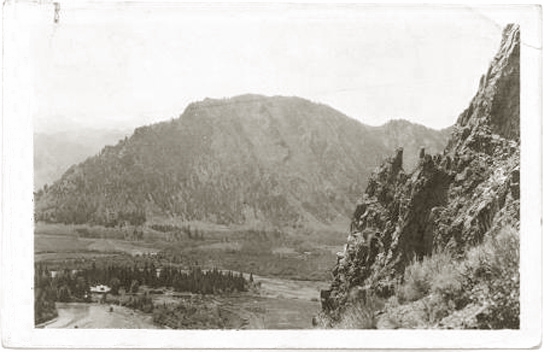
Sunlight Basin, 1926.
Shortly after 1:00 p.m., 17 year old Tipton "Tip"
Cox was skipping class and was lounging at Otis Roulette's Texaco Station and
Goodyear store across the street from the bank. In the bank, in addition to Knutson and Gawthrop, were the
bank's president, vice-president and five customers. Across the street in the St. John's drugstore was a
part-time employee George Blivins. It is unlikely that that any heeded Harry Moore's Buick as it parked about 100 feet to the
east of the Bank. Harry Moore was the radio operator at the Hopkins Ranch. But Harry was not in the
vehicle. At that moment, he was on foot miles away seeking a phone.
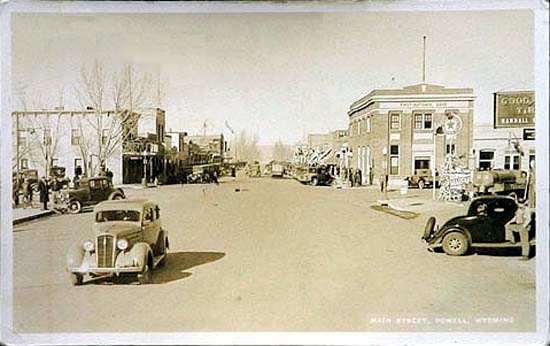
Powell, Wyo., 1939. Roulette's Service Station on right,
First National Bank of Powell on corner,
the Coffee Cup Cafe is to the right of the bank.
All at once, the sound of shooting from within the bank alerted citizenry that something
was amiss at the Bank. Blivens placed a call to the Billings Gazette for whom he wrote. The
Gazette, in turn, relayed the call to KGHL. Thus, citizens within range of the station's
signal listened live to the situation. Other bulletins went out to other news media. Newspapers had
already been whipped into a feeding frenzie over reports from the possee and the
events of the prior nine days. The Denver Post and national wire services referred to Earl as the
"Tarzan of the Tetons." they repeated rumors that he loved to eat his meat raw. In Powell upon hearing the shots,
armed citizens appeared from everywhere, rooftops, doorways, windows. From the bank emerged Earl using the bank President Bob Nelson,
Knutson, and Gawthrop as human shields. It seemed as if shooting came from
everywhere. One bullet went through the glass of the office door of the hotel across the street, narrowly missing
the owner's pet canary./p>
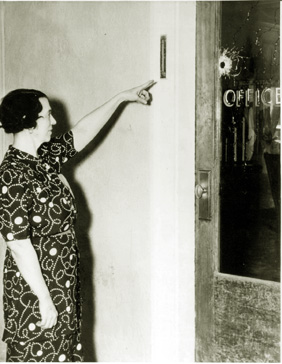 . . . . . .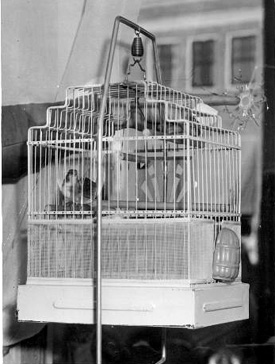
Left: bullet hole in door of hotel; Right: Canary, bullet hole to the right and above the
canary's cage.
In the avalanche of bullets, Gawthrop fell mortally wounded.
It appeared as if Earl was aiming his Winchester at Tip Cox in the doorway of the service station. Tip
grabbed Roulette's rifle and took aim at Earl, hitting him. Earl staggered back into the
bank where he committed suicide. As Johnny Gawthrop lay dying on the sidewalk, he groaned,
"I'm glad it was me, and not one of the married men." Tip took Gawthrop to the hospital, but it was too late.
Gawtrhrop died as Tip pulled into the hospital.
Crowd's gathered everywhere. The press had a field day, taking photographs of anything related to the
events at the bank including the canary.
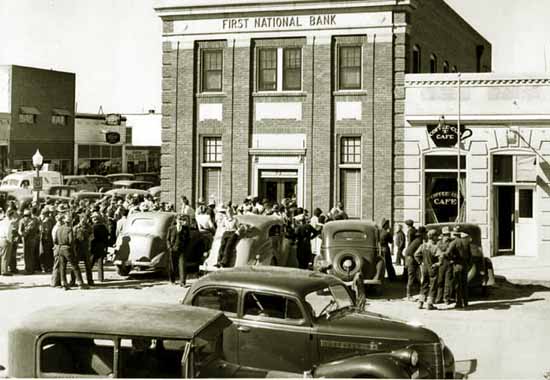
Crowds in front of bank following Durand shooting, Powell, Wyo.
And what brought about the above events? It started with four poached elk. On Monday, March 13, 1939, a complaint was
received that someone was killing elk out of season along the Cody Road 26 miles above Cody. Game wardens
Boyd Bennion and Dwight King investigated and stopped at gun point a car driven by Gus Knopp of Powell.
Inside were Knopp, Knopp's son age 15,
the son's friend age 16, and an individual later identified as Earl Durand. Earl leaped from the
car and disappeared into the darkness. Parts of two elk are found in the trunk. The three passengers remaining in the car were taken
to Cody where they were booked into the jail. The next day, North Fork rancher John A. Yeates discovers two of his cattle have been shot. One was dead
with a part of its flesh removed. This led later to newspapers reporting that Earl ate the
flesh raw. Durand is tracked in the snow by Undersheriff Noah Riley and is arrested. It was reported that at the
time of his arrest, Earl was eating a piece of raw mean. Durand and the elder Knopp pled guilty. Durand was
sentenced to six months in the county jail and a fine, the elder Knopp to two months and a fine and
the two juveniles were lectured and let go. Additionally, the prosecuting attorney begins the process of
charging Durand with the felony killing of the cow. Later there were rumors that
the undersheriff taunted Durand by telling him he was to be sentenced to Rawlins for twenty years.
In the 1930's, sheriff's offices in rural counties were typically small. The jail might be manned by
the sheriff's family and there might be a deputy assigned to different areas of the County. At the time, Sheriff Frank Blackburn was picking up prisoners
in California. With the absence of the sheriff, general law enforcement in Park County was
entrusted to Riley; a 68-year old deputy in Powell, David M. Baker; and the Powell Town Marshal Charles "Chuck" Lewis. Lewis had
previously served as First Sargeant in the old Company C of the Wyoming National Guard and saw duty in France as a part
of Battery F of the Field Artillery. Thus, the jail was manned by the sheriff's daughter and by the undersheriff Noah Riley. On
Thursday, March 16, Riley brings the inmates their meals. When Durand's cell was opened, Earl grabbed a bottle of
milk off the tray and cracked Riley over the head, giving him a
concussion and earning Riley the nickname "Milk Bottle." Durand took Riley's gun, releaseed the
remaining prisoners and lead Riley out of the jail to Riley's car. Bob Alsup, a friend of Riley's and later
the operator of the Cody Sportings Goods Co., noted something peculiar, the inmate was leading the
deputy, not the other way around. Alsup followed Riley's car until waved off by Durand. He gave the
alarm which was telephoned to Deputy David M. Baker in Powell. A description of the car was broadcast over
KGHL. The Riley automobile was spotted near Powell. Deputy Baker and Powell Town Marshal Lewis proceeded to the
Durand homestead with the intent of freeing Riley and rearresting Durand. There, Durand forced Riley and his father, against the entreaties of
both parents, to help pack his belonging. At the homestead,
Durand shot both the Deputy and the Marshal. Deputy Baker died on the scene. Durand fled and Riley escapes
by hiding behind a tree. Riley made his way across fields to Otto Smith's. The elder Durands emerged from their home and discovered the wounded marshal and took him
to the Powell hospital where he expired. Smith took Riley to the hospital. From the hospital Riley called sheriffs in
neighboring counties in Montana and Wyoming. In the meantime, in Cody, the county attorney proceeded to the
jail to discover the inmates milling about outside. He put them back in the jail and designated a game warden to be in
charge of the recapture effort.
A 100-man posse was organized, a portion of which was under the command of the game warden.
The county attorney hired an airplane and
pilot to aid in the search. Nothing was found. The pilot was later employed to go to
Casper to obtain tear gas bombs. It was later learned that Durand was hiding along
Bitter Creek a short distance outside of Powell. On Saturday Sheriff Blackburn returned from
California and took charge. On Tuesday, March 21, Durand appeared at Herf Graham's, stole a rifle, and left a note for
Sheriff Blackburn, later reprinted in the Powell Tribune, threatening the lives of the Sheriff and the prosecuting attorney, offering the two game wardens
an opportunity for an even draw, and concluding:
Of course I know that I'm done for and when you kill me I suggest you have my
head mounted and hang it up in the court house for the sake of law and order
Your Beloved enemy,
Earl Durand
p.s. I know where King [one of the game wardens] lives, so he may expect me
around any time to shake hands.
Durand showed his return address as the undertaker's.
On Wednesday morning, Durand broke into Art Thornburg's house and forced the
Thornburgs to drive him to Clarks Fork Canyon about 55 miles from Powell. That evening,
Durand's position near the canyon was discovered. Two members of the posse, Rodeo cowboy Orville Linaberry and Meeteetse
resident Art Argento attempted to rush Durand's position and were killed in the
process. When their bodies were finally recovered, Linaberry's shoes were missing as
were the laces from Argento's boots. The laces were later used in the bank to tie the
human shields together.
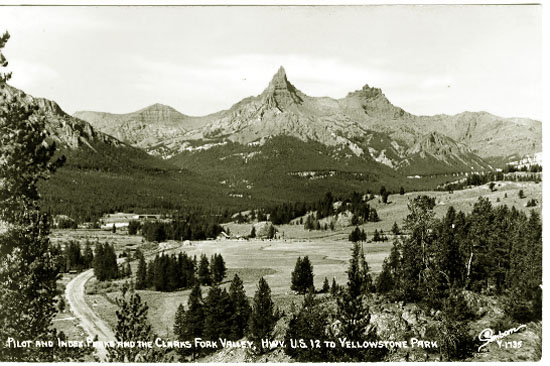
Clerks Fork Valley, 1930's. Photo by Wm. P. Sanborn.
Unbeknownst to the posse, Durand worked his way down to near the highway where, using Argento's
deputy's badge, he hailed down Harry Moore's Buick. In the Buick, in addition to Moore, were
John Simpson and his 86-year old father Peter Simpson. Durand forced Moore to drive to Deaver 16 miles east of Powell where he
picked up additional amunition. In Deaver, Durand stoped for gas and paying for it himself telling Moore it was only
"fair." From Deaver, Durand took his three passengers to a coal mine where he left them to walk three miles to
the closest ranch.
Following, Durand's death inside the bank, his body was taken to Easton's funeral home where it was
placed in a position of repose on a sofa for the thousands that came to Powell. The next day a private
graveside ceremony was conducted at the Crown Hill cemetery. Tip Cox had a moment of fame. He was flown to
Denver for an appearance on a radio program. Later he was flown to New York
for an appearance on a national radio show. He appeared in news reels. Noah Riley died in 1973. Knudson sold his stock in the bank and
moved to Sweet Grass County, Montana. He later returned to Powell. Years later he
repurchased the stock and again became a director. Bill Alsup, who first gave the alarm as to the
jail break, died at age 94, in February, 2004. The elder Durands moved from Powell and ultimately
settled near Boise, Idaho. Walter W. Durand died in 1966 and Effie Jane died in 1972. Two years later,
the world premier of a movie filmed near Pinedale, The Legend of Earl Durand, was held at the
Teton Theatre in Powell. It attempted to portray Earl as a misunderstood Robin Hood. A number of
local residents walked out.
Next page: Heart Mountain Relocation Camp.
|